That is a good one. 🙂
Alpha 20 and similar is described here:
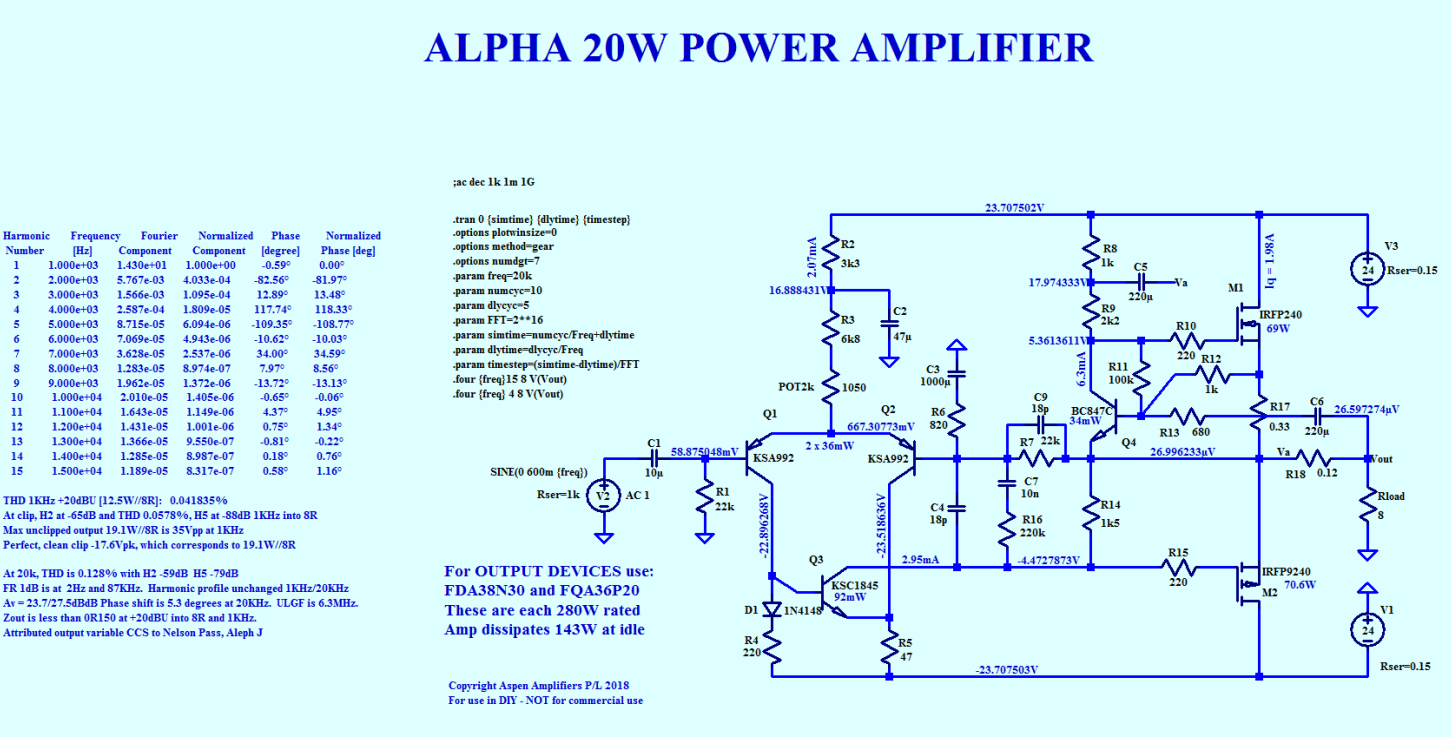
Alpha Nirvana is described here:
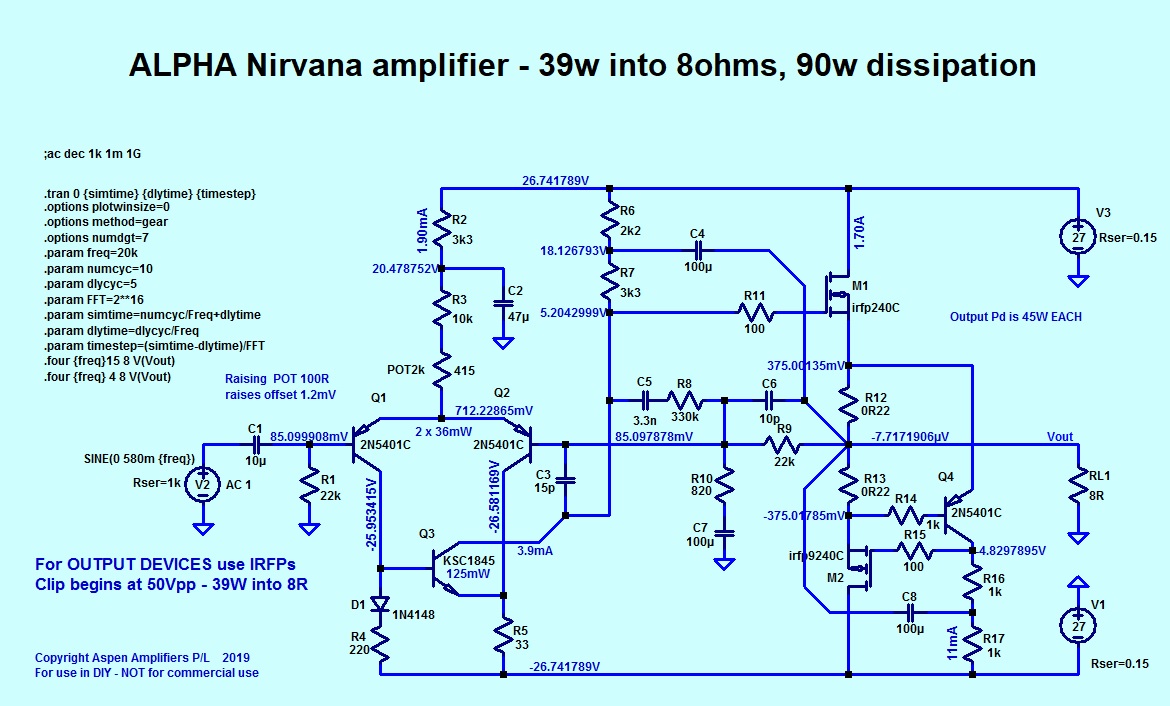
These are Hugh Dean amps but I'll try to describe what I think are teh differences. The Alpha Nirvana's active CCS is no longer based on the Pass Aleph topology but a PNP-BJT controlled P-channel output MOSFET with symmetric sense resistors. It also has some refinements in the frequency dependent feedback to give it higher damping factor in the bass region for excellent grip of the woofer.
Alpha 20 and similar is described here:
Alpha Nirvana is described here:
These are Hugh Dean amps but I'll try to describe what I think are teh differences. The Alpha Nirvana's active CCS is no longer based on the Pass Aleph topology but a PNP-BJT controlled P-channel output MOSFET with symmetric sense resistors. It also has some refinements in the frequency dependent feedback to give it higher damping factor in the bass region for excellent grip of the woofer.
Is there any advantage of building the alpha 20 over the alpha nirvana?
I am only wondering why there is still interest in alpha 20 if a better more modern and better sounding alpha nirvana exist?
I am only wondering why there is still interest in alpha 20 if a better more modern and better sounding alpha nirvana exist?
Is there any advantage of building the alpha 20 over the alpha nirvana?
I am only wondering why there is still interest in alpha 20 if a better more modern and better sounding alpha nirvana exist?
Simpler PCB that is UMS heatsink compatible with MOSFETs directly mounted to PCB. The sound is still excellent.
Anand, any updates? I'm very interested to hear your subjective impressions/comparisons of all the amps you've tried so far in the NPXP.
I know, I saw that one. That's actually what provoked me to ask. Wondering how the AN compares to everything else he's tried so far.
@stretchneck
M2X experiments currently, THEN Babelfish M25.R2 which to me is the culmination of that series of amplifiers...
Best,
Anand.
M2X experiments currently, THEN Babelfish M25.R2 which to me is the culmination of that series of amplifiers...
Best,
Anand.
Amazing work Anand. I learn so much from your posts! Dave M.
That's a great review. Now I may have to build one, as it's the only way to really find out. Since my speakers are current hogs, they're slightly under powered (recommended minimum 50W) which is why I was looking to bump the AJ up in power as they are a bit shallow in bass.Hi fellas!
I think it's high time that I write a short review of the DIY Audio Store Aleph J and Zen Mod's Aleph J Zen designs. I have auditioned both quite extensively in my system.
System details are here.
System pics, room description and LF measurements are here.
As a reminder, this is what my DIY Audio Store Aleph J build looks like:

And Zen Mod's excellent Aleph J Zen design:



So a little word on some of the technical differences between the two designs. It's very easy to see that ZM has tightened up his version particularly in a more compact layout, use of cascode regulation for the input JFETs and finally some current sources. The output stage uses the Aleph CCS but with IRF 150's which provide intrinsic matching! As such it is a much more turnkey method of building an Aleph J. There is no need for matching the output devices whatsoever.
One notable difference in my build of the AJ Zen was I made it direct coupled, i.e. input capacitor C1 was replaced with a wire. This was only possible in my system as my source is a differential DAC which has little to no DC offset and also because my input JFETs (LSJ74's) are very closely matched. My dc offset stayed under 10mV, so no worries there.
On to the subjective differences. I listened at primarily 80-100dB SPL levels at approximately a 4m distance with speakers that are 96dB sensitive. They have an impedance nadir of 4.8 ohms and max of ~ 16 ohms at >100Hz.
As expected the two designs sound more similar than different. The Aleph J Zen has a tighter mid bass and a more transparent and extended upper midrange. This translates into even deeper sound staging versus the standard Aleph J and a tone that is more neutral. This can be a double edged sword however. In systems where the loudspeaker in question doesn't have much bass extension or even mid bass prowess if you will, I imagine the AJ Zen can sound a tad forward and dry. It also may not be the best choice for poor recordings and highly compressed recordings. The standard Aleph J had a more 'ripe' mid bass that was 'plump'. It was not boomy however. The upper midrange/treble was also softer and subtle sounding which was nice for literally all of my recordings. I could listen for several hours at a time. Like a warm blanket if you will. However because of that buttery smoothness, there was a lack of attack with trumpets, soprano voices, etc....which makes total sense. With the best recordings, the AJ Zen would hold you fastidiously to your seat while with the standard Aleph J, you could literally walk away from your seat and not feel like you missed too much. I was pretty surprised by those tonal differences but do not see either one as better or worse.
Both designs had excellent sound staging although the AJ Zen was better at maintaining imaging precision. Blacks were blacker with the AJ Zen so images were more precise in the aural scene. The standard Aleph J was more murky in comparison but nonetheless enjoyable.
While listening to the Aleph J I often thought that this amp design would pair well with a small 2 way (i.e a 5 to 6 inch midbass driver) with limited bass extension. That would augment the deficiencies of the small 2 way design. The AJ Zen by comparison would pair more readily with a system that has more prodigious bass extension.
I thoroughly enjoyed both designs and listened to each of them for about 2-3 weeks. I can clearly see the advantages of the Aleph CCS and the fact that the Aleph J is still RELEVANT today in the massive milieu of amp designs says something. Thank you so much Mr. Pass! It's a timeless classic and I encourage all greedy boys to give them both a listen!
Best,
Anand.
P.S. Next on the bench is XRK/Hugh/JPS's ALPHA 20, another Aleph CCS variant...😀
Time to resurrect this thread! It’s been a bit and I’ve been busy, mostly tending to myself and my health since DIY does take up a lot of one’s spare time.
Earlier this summer, I decided to rebuild my NPXP which had my Alpha Nirvana encased in it and sounding super nice. This time around I implemented Tungsten’s excellent version of the F6 which has everything I would hope for and is scaleable for power as well. My supplies remain +/-24V so we are mostly sticking with 25 watts/8 ohms and 50 watts/4 ohms. In addition I used the IXTQ75N10P output mosfets which sound divine in this circuit biased at 1.8A. For the transformer, I had some Cinemag CMOQ 4HPC (80% high nickel) pressed into service. Finally, I added a cap bank, about 32mF/ch as I recall.
I was disappointed with the internal organization of my NPXP (see 2nd photo, 1st post of this thread) and particularly the grounding scheme. So what you see is something more organized. With the ground lift circuit in place and the T-board, it’s a very quiet amp rendering all the minute details I love to hear. DIY builds are all about the subtle details and tweaks.
Best,
Anand.
Earlier this summer, I decided to rebuild my NPXP which had my Alpha Nirvana encased in it and sounding super nice. This time around I implemented Tungsten’s excellent version of the F6 which has everything I would hope for and is scaleable for power as well. My supplies remain +/-24V so we are mostly sticking with 25 watts/8 ohms and 50 watts/4 ohms. In addition I used the IXTQ75N10P output mosfets which sound divine in this circuit biased at 1.8A. For the transformer, I had some Cinemag CMOQ 4HPC (80% high nickel) pressed into service. Finally, I added a cap bank, about 32mF/ch as I recall.
I was disappointed with the internal organization of my NPXP (see 2nd photo, 1st post of this thread) and particularly the grounding scheme. So what you see is something more organized. With the ground lift circuit in place and the T-board, it’s a very quiet amp rendering all the minute details I love to hear. DIY builds are all about the subtle details and tweaks.
Best,
Anand.
Attachments
-
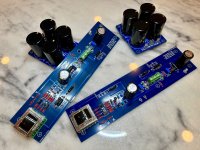 IMG_0115.jpeg924.2 KB · Views: 250
IMG_0115.jpeg924.2 KB · Views: 250 -
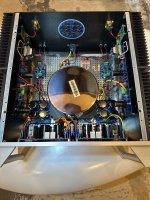 IMG_0149.jpeg1 MB · Views: 253
IMG_0149.jpeg1 MB · Views: 253 -
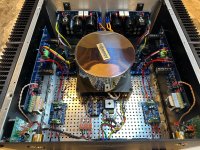 IMG_0153.jpeg1.1 MB · Views: 224
IMG_0153.jpeg1.1 MB · Views: 224 -
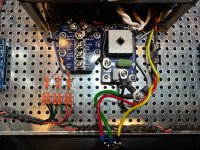 IMG_0159.jpeg1.2 MB · Views: 237
IMG_0159.jpeg1.2 MB · Views: 237 -
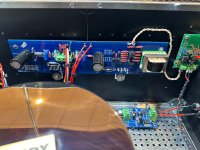 IMG_0156.jpeg828 KB · Views: 228
IMG_0156.jpeg828 KB · Views: 228 -
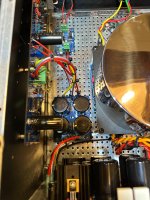 IMG_0151.jpeg975.7 KB · Views: 221
IMG_0151.jpeg975.7 KB · Views: 221 -
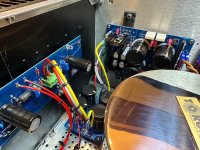 IMG_0158.jpeg966.1 KB · Views: 218
IMG_0158.jpeg966.1 KB · Views: 218 -
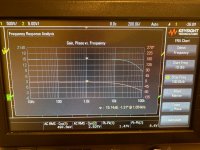 IMG_0162.jpeg931.7 KB · Views: 209
IMG_0162.jpeg931.7 KB · Views: 209 -
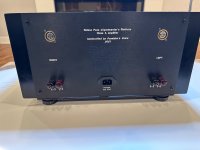 IMG_0154.jpeg593.6 KB · Views: 236
IMG_0154.jpeg593.6 KB · Views: 236
Good to see you back Anand! Great looking build as usual - is this one I’ve heard???
-Mike
-Mike
Anand,
Beautiful work... kudos!
The neat organization, the multi-colored colored wiring with mirrored curves/twists on both sides, multiple circuit boards, and the shiny transformer in the middle somehow reminded of something out a Sci-Fi movie...🙂
Beautiful work... kudos!
The neat organization, the multi-colored colored wiring with mirrored curves/twists on both sides, multiple circuit boards, and the shiny transformer in the middle somehow reminded of something out a Sci-Fi movie...🙂
Great to see more action happening on your NPXP platform.
Lovely work, Anand🤩
Lovely work, Anand🤩
Anand,
I'm glad you're back in action. Very neat build. Best Regards, Bill
I'm glad you're back in action. Very neat build. Best Regards, Bill
Nice work as always, Anand!
How does the F6 sound compared to the others?
How does the F6 sound compared to the others?
More neutral than the Aleph J variants and other single ended output stages on this platform. Much more resolution than a standard F6. More harmonic texture. Tight clean bass, not as deep as the finest Class AB designs but good enough to be honest. Staging is wide and deep. This is in fact my first push pull design in the NPXP. Since my main speakers are 96dB sensitive, the 25 watts/8 ohms and 50 watts/4 ohms (nearly all of it in Class A since my bias is at 1.8A) power hasn’t been an issue.
Tungsten’s marriage of Mark Johnson’s “Austin” input board + Cinemag phase splitting transformer + N channel high transconductance MOSFETS is a good one! I hope @Monk55 completes his build! We missed him at BAF24 this year!
Best,
Anand.
Tungsten’s marriage of Mark Johnson’s “Austin” input board + Cinemag phase splitting transformer + N channel high transconductance MOSFETS is a good one! I hope @Monk55 completes his build! We missed him at BAF24 this year!
Best,
Anand.
- Home
- Amplifiers
- Pass Labs
- Nelson Pass eXperimenter's Platform (NPXP)